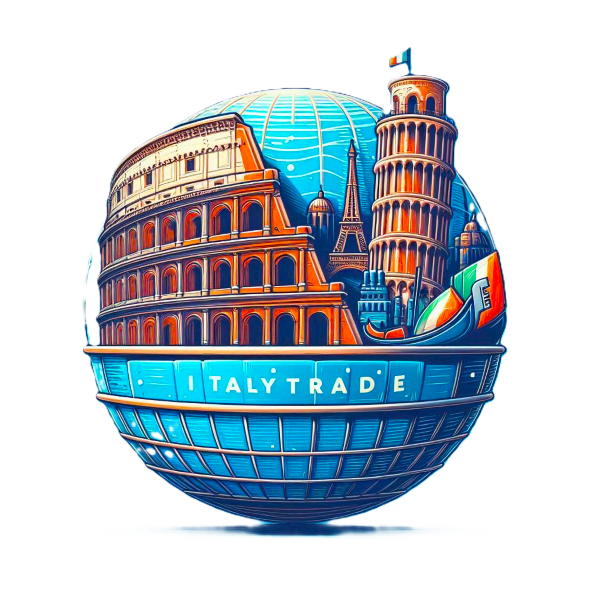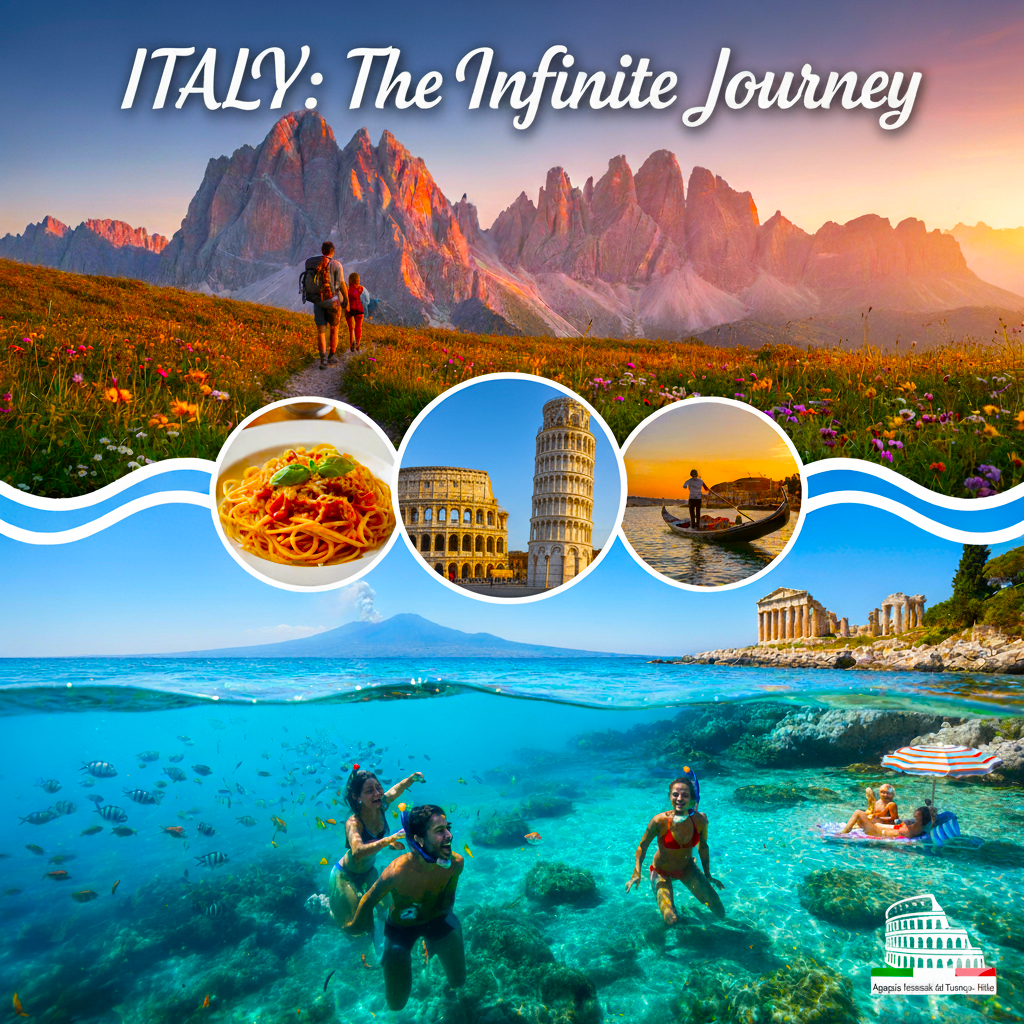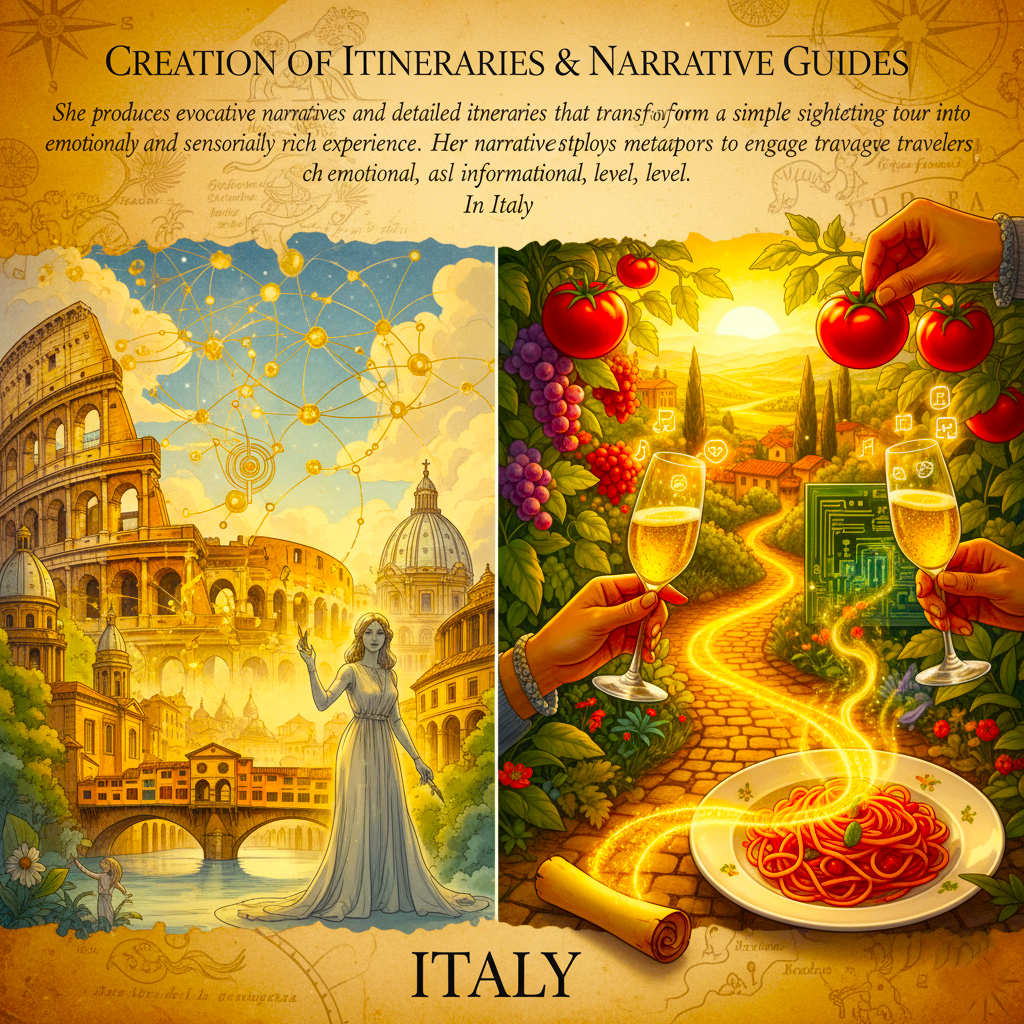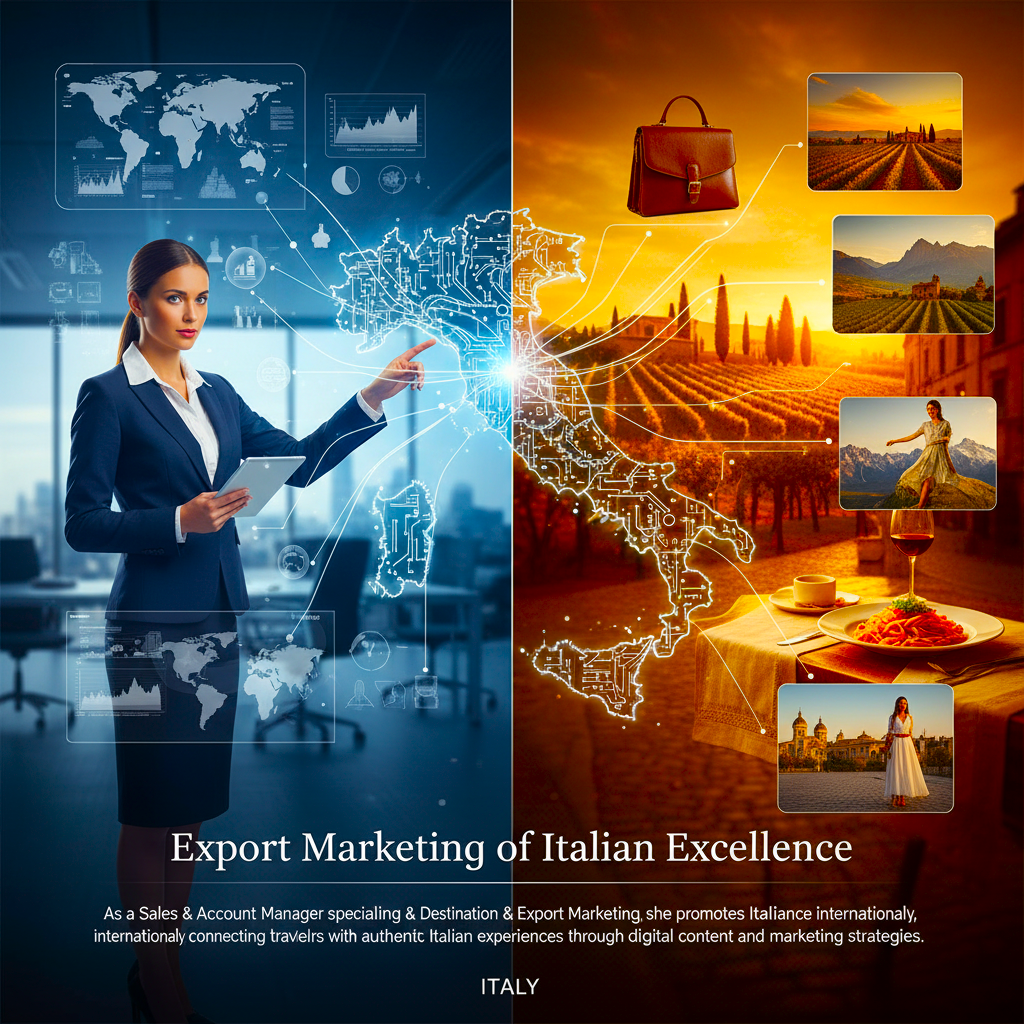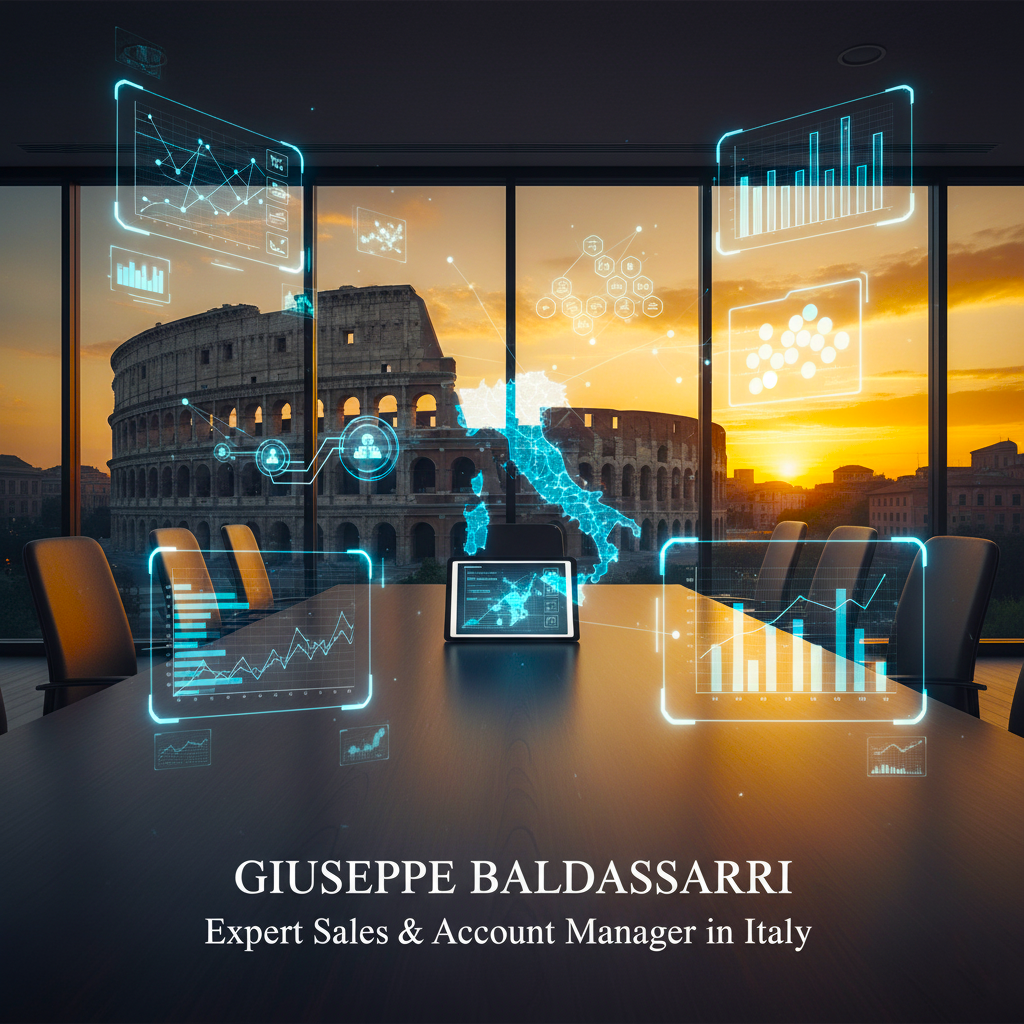
Giuseppe Baldassarri ✓Sales & Account Manager – Destination & Export Marketing in Italy
The Cartographer's Journey: A Story of Connection and Discovery
By Baldassarri Giuseppe ✓
Sales & Account Manager – Destination & Export Marketing in Italy
Imagine a master cartographer who doesn't simply draw maps. Instead, he walks every path twice—first with his eyes closed, feeling the texture of ancient cobblestones beneath his feet, listening to the whispers of wind through medieval archways, tasting the salt air that drifts inland from distant shores. Only then does he open his eyes and begin to sketch, not just the geography of a place, but the invisible lines that connect a traveler's anticipation to their transformation, the pathways between longing and belonging. His maps are alive—they shift with seasons, respond to touch, and reveal themselves differently to each soul who holds them. This is not cartography. This is the art of creating passages between worlds.
My name is Giuseppe Baldassarri, and I work in Destination & Export Marketing in Italy. However, let me explain what that really means.
I was born in Porto San Giorgio, in the province of Fermo, in the Marche, a region in central Italy—the only one with a plural noun, le Marche, as if even its name acknowledges that it contains multitudes. It's a place that refuses to be singular, to be easily defined. Here, the Apennine mountains descend in gentle waves toward the Adriatic Sea, creating a landscape that is both rugged and tender, ancient and alive. Medieval hilltop towns crown the ridges like weathered sentinels, their honey-colored stones glowing at sunset. Below, valleys fold into one another, concealing Renaissance treasures and family-run agriturismi where the same recipes have been passed down through generations whose hands shaped the pasta with the same loving precision.
Growing up here taught me something essential: a place is never just what you see. It's what you feel when morning light filters through the loggia of Urbino's Ducal Palace. It's the taste of olive all'ascolana—those perfect spheres of fried deliciousness—still hot from a street vendor's oil. It's the sound of your own footsteps echoing in the silence of Frasassi Caves, where time itself seems to have crystallized into stalactites. It's the story the fisherman tells you in Senigallia while mending his nets, his weathered face a map of his own journey across these same waters.
This understanding became the foundation of everything I do.
When people ask me about my work, they often expect technical answers about market analysis, promotional strategies, and distribution channels. And yes, those are the tools in my kit. But that's like describing a symphony by listing the instruments. What I really do is much more intimate, more human.
I help people fall in love—with places, with experiences, with versions of themselves they haven't yet met.
Every destination has a soul, but not everyone knows how to introduce that soul to the world. Italy, my Italy, is rich beyond measure—not just in art and history, but in those unexpected moments that change how you see the world. A conversation with a nonna who insists you try her homemade mistrà. The discovery of a hidden garden behind an unmarked door in Recanati. The realization, standing in the silence of Loreto's basilica, that you're touching something that has moved millions of hearts across centuries.
My role is to create bridges—not just between Italy and international markets, but between what a place offers and what a traveler secretly seeks, often without knowing they're seeking it.
Let me share how this works in practice.
I remember working with a consortium of small producers in the Marche—winemakers, olive oil artisans, cheese makers—who created exceptional products but struggled to find their voice in global markets. They didn't need a better product; they needed someone who could translate their passion into a language that resonated across cultures and continents.
So I didn't start with a marketing plan. I started by sitting at their tables.
I listened to Marco, the third-generation vintner, explain how he can taste the difference between grapes from the east-facing slope and the west-facing slope of his vineyard—not because of some mystical gift, but because he's walked those rows every day since childhood, in every season, in every weather. His wine wasn't just a beverage; it was a conversation with the land itself.
I watched Anna, the casara, as she turned the wheels of her pecorino, each one marked with the date and a small notation in a code only she understood. She didn't just make cheese; she created time capsules of specific moments—that week's weather, that month's pasture, that season's particular quality of light.
These weren't products. They were stories made tangible, experiences crystallized into form.
The challenge wasn't convincing buyers that these offerings were good—objective quality was never in question. The challenge was helping people understand that choosing them meant choosing to participate in something larger: a tradition, a relationship with land and time, a different way of being in the world.
So we built the approach around the journey—not just the physical journey to the Marche, but the emotional and sensory journey of discovery. We created tasting experiences that weren't about rating and scoring, but about understanding context and connection. We invited buyers to the vineyards at harvest, to the caves where cheese ages, to the groves where olives ripen under the same sun that warmed Roman legions.
We let them see Marco's hands, stained purple with grape skins. We let them hear the hollow thump of Anna's knuckles against a perfectly aged wheel of cheese. We let them taste the difference that care makes.
And we invited them to imagine their own customers experiencing that same sense of discovery—the restaurant patron who asks about the wine and hears a real story, the home cook who drizzles that olive oil and feels connected to a place they've never been, the cheese lover who closes their eyes and, for just a moment, stands in a mountain pasture in central Italy.
This is the heart of what I do: I don't sell destinations or products. I create conditions for transformation.
Every person who travels, who tastes, who explores is on a journey that's both outward and inward. They're seeking something—beauty, authenticity, meaning, connection, escape, belonging. Often, they don't articulate this, even to themselves. They just know something is calling them.
My work is to understand that call, to sense what lies beneath the surface of "I want to visit Italy" or "I'm looking for artisanal products." Because what they're really saying is: "I want to feel alive. I want to discover something that makes me see the world differently. I want to be part of something real."
The Marche taught me to see beneath surfaces. In a region that's not as immediately famous as Tuscany or Venice, you learn that the deepest treasures don't announce themselves. They wait to be discovered by those who know how to look, how to listen, how to open themselves to possibility.
Loreto's basilica doesn't shout. It stands, quiet and powerful, and millions come because something in their soul recognizes something in that place. Recanati doesn't market itself as "the town where Giacomo Leopardi wrote L'Infinito"—it simply invites you to stand where he stood, look at the same hedge that blocked and revealed infinity for him, and discover what infinity means to you.
This is the marketing I believe in: creating invitations, not advertisements. Opening doors, not making claims. Trusting that when the right person meets the right experience, something magical happens—without force, without manipulation, through simple, profound recognition.
In my years working across Italian destinations and with international markets, I've learned that the best outcomes emerge when you prioritize understanding over assumption. Before creating any strategy, I immerse myself in the place and the people. I walk the streets at different times of day. I eat where locals eat. I ask questions and then ask follow-up questions. I pay attention to what makes people's eyes light up when they talk about their work, their home, their traditions.
Then I turn that same careful attention toward the markets we're trying to reach. What are they truly seeking? What fears do they carry? What dreams? What past experiences shape their expectations? What would make them not just visit or buy, but feel genuinely moved by the experience?
The sweet spot—where magic happens—is where authentic offering meets genuine need. Not manufactured needs created by clever advertising, but the deep human need for meaning, beauty, connection, and transformation.
This requires patience. It requires empathy. It requires the willingness to start with questions rather than answers, to prototype and adapt, to listen to feedback—both spoken and unspoken. It requires honoring both the integrity of what we're sharing and the humanity of those we're sharing it with.
The Marche remains my greatest teacher. This region of contrasts and harmonies, of mountains and sea, of silence and song, continues to reveal new dimensions. Each season brings different light, different crops, and different reasons to celebrate. Each town has its own festivals, its own specialties, its own particular way of being Italian while being distinctly, proudly itself.
When I take buyers through the region, or when I develop campaigns for international markets, I'm not trying to put the Marche on the map in the conventional sense. I'm trying to create the conditions where people can experience what I experienced growing up here: the realization that the richest experiences aren't always in the most obvious places. That authenticity has a flavor, a texture, a resonance you can't fake. That the journey matters as much as the destination. That being open to surprise leads to the most profound discoveries.
So yes, I'm a Sales & Account Manager in Destination & Export Marketing. But what I really am is a bridge builder, a story translator, a creator of conditions for meaningful connection.
I work at the intersection of place and person, tradition and innovation, local and global. I help Italian excellence find its way into the world, and I help the world find its way to the heart of Italian experience.
The work requires both head and heart—strategic thinking and genuine feeling, market analysis and human intuition, professional expertise and personal passion. It requires understanding that every traveler is on a journey, every buyer is making a choice about what kind of world they want to participate in creating, and every experience is an opportunity for transformation.
The cartographer I described at the beginning? That's how I see myself—mapping not just physical territories, but the emotional and experiential pathways that connect people to places, products to meaning, transactions to relationships.
And like that cartographer, I know that the best maps are the ones that leave room for discovery, that invite exploration, that transform not just where you go, but who you become along the way.
This is the work that calls me. This is the work I'm honored to do.
This is what it means to bring Italy to the world, and the world to Italy—one connection, one story, one transformed heart at a time.
Giuseppe Baldassarri
Sales & Account Manager
Destination & Export Marketing in Italy
Born and raised in Le Marche—where the mountains meet the sea, and every journey begins with a plural.
The Maestro of Bridges: Where Commerce Meets Soul
I stand as a master craftsman before a rushing river at dawn. On one bank, orchards heavy with fruit; on the other, distant markets humming with anticipation. I don't simply build a bridge—I study the water's temperament, feel the rhythm of seasons in my bones, understand that each plank must sing a different note to the traveler's footstep. Some planks offer rest, others surprise; some whisper of home, others promise adventure. The bridge becomes more than a passage—it transforms into an experience etched in memory, where every crossing tells a story that travelers carry forward, becoming storytellers themselves.
Narration by Giuseppe Baldassarri ✓ Sales & Account Manager – Destination & Export Marketing in Italy
Introduction: The Art of Connection in Italian Commerce
In the labyrinth of Italian commerce, where centuries-old craftsmanship meets modern global markets, I've learned that selling isn't about transactions—it's about orchestrating moments that resonate long after the contract is signed.
Twenty years navigating Italy's intricate business landscape has taught me this: every client's journey begins not with a product catalog, but with understanding the unspoken language of their aspirations. The Ferrari dealer in Dubai doesn't buy Italian luxury cars; he purchases the poetry of speed embodied in Modenese engineering. The boutique hotelier in Tokyo sourcing Tuscan olive oil isn't ordering condiment—she's bottling the golden light of Mediterranean afternoons for her guests.
The Role of a Sales & Account Manager: Beyond Numbers
Key Responsibilities That Define Excellence
My days dissolve the boundaries between strategist, cultural translator, and relationship architect:
Sensing and Responding—Before presenting solutions, I immerse myself in the client's ecosystem. A German tour operator isn't seeking "Italian vacation packages." They're curating transformations: the moment when a stressed executive first tastes handmade pasta in an Umbrian farmhouse and remembers what joy feels like.
Creating Touchpoint Symphonies—Every interaction—from first email to post-sale follow-up—must feel intentional. When I send a prospective client a bottle of Sagrantino from Montefalco, it arrives with a handwritten note about the winemaker's grandmother's recipe, not a sales pitch. The bottle becomes a sensory ambassador, speaking volumes before our first meeting.
Problem-Solving as Co-Creation—The French luxury goods distributor who needed Italian leather suppliers didn't just want contacts—they needed partners who understood their brand's soul. I arranged a three-day immersion in Tuscan tanneries, where artisans demonstrated techniques unchanged since the Renaissance. The resulting partnerships weren't negotiated; they were forged in shared understanding.
The Invisible Skills That Matter Most
Account management demands fluency in unspoken languages:
- Reading the pauses in conversations where clients reveal their true concerns
- Recognizing patterns in market shifts before data confirms them
- Balancing advocacy for both client needs and Italian supplier capabilities
- Cultivating patience in cultures where relationships precede contracts
Destination Marketing: Selling Italy's Intangible Soul
Overview: Marketing Places as Living Stories
Italy isn't a destination—it's a thousand destinations nested within each other like Russian dolls. My work in destination marketing means becoming a curator of experiences that visitors will replay in their minds for decades.
Consider the Dolomites. Standard marketing touts hiking trails and ski slopes. But I learned from watching visitors' faces that what they truly seek is that specific quality of alpine silence—so profound you can hear your own heartbeat—interrupted only by distant cowbells. Marketing the Dolomites means marketing that silence, that heartbeat, that cowbell.
Impact on Tourism and the Living Economy
When done with intention, destination marketing becomes economic poetry:
The medieval village of Spello in Umbria was fading—young people leaving, shops closing. We didn't market "an authentic Italian village experience." Instead, we amplified the village's annual Infiorata festival, where residents create massive flower petal carpets through the streets. We filmed the grandmothers' hands sorting petals at dawn, the children's concentration as they perfected petal patterns, and the collective exhale when visitors gasped at the finished artwork.
The result? Spello became a pilgrimage site for travelers seeking a connection to a slower time. Flower petal art workshops now run year-round. Three new agriturismos opened. Young people returned to manage them. The village's economy didn't just grow—it blossomed.
Export Marketing: Translating Italian Excellence Across Borders
Understanding the Export Market's Hidden Dimensions
Italian exports carry centuries of cultural weight. A Parmigiano-Reggiano wheel isn't just cheese—it's the embodiment of consortiums protecting 900-year-old production methods, of specific grasses that cows must eat, of the distinct crack when the wheel is opened with traditional almond-shaped knives.
My work begins where product specifications end: How do we help an American gourmet shop owner understand that the price differential between Parmigiano-Reggiano and generic Parmesan isn't markup—it's the cost of preserving cultural heritage? How do we make that meaningful to their customers?
Best Practices: Creating Cultural Resonance
Storytelling as Infrastructure—Every export partnership I develop includes narrative assets. When I connected a Tokyo department store with a Murano glassmaker, we created a video series showing the maestro's 40-year journey from apprentice to master. Sales increased 300% because customers weren't buying vases—they were purchasing a lifetime dedication made tangible.
Adaptation Without Dilution—A Chinese luxury market demanded Modena balsamic vinegar in smaller bottles with more decorative packaging. Instead of resisting, we worked with the producer to create a "tasting journey" set: five small bottles representing different aging periods, packaged in a handcrafted wooden box with tasting notes that taught customers to appreciate complexity. Premium positioning maintained, cultural education embedded, market needs met.
Building Advocate Networks—Rather than seeking maximum distribution, I cultivate deep partnerships with select retailers who become Italian ambassadors. A single specialty food shop in Sydney, run by a passionate owner who personally visits suppliers, does more for Italian exports than twenty indifferent supermarket chains.
Navigating Challenges: When Bridges Face Storms
Sales and account management in international markets present obstacles that test both resolve and creativity:
Cultural Misalignments—The American expectation of immediate responses clashes with Italian relationship-building timelines. I've learned to create what I call "bridging rituals"—video calls that combine efficiency with personal connection, or shared meals via simultaneous dining calls across time zones.
Economic Volatility—Currency fluctuations, trade policy shifts, pandemic disruptions. When COVID-19 halted tourism, I pivoted destination marketing toward "virtual immersions" and "future travel credits," maintaining relationships through impossibility.
Quality Versus Scale Tensions—A Japanese restaurant chain wanted to import artisanal pasta from a small Abruzzo producer. Volume demands threatened the very craftsmanship that attracted them. Solution: We created a "heritage line" at higher prices with limited quantities, and a "inspired by" line at scale using the artisan's recipes with contracted production. Both markets served, integrity maintained.
Building Relationships That Transcend Transactions
Techniques for Authentic Communication
The most valuable skill I've developed isn't found in any sales manual:
Active Silence—Learning when not to speak. Allowing clients to articulate needs they didn't know they had. Creating space for the unexpected insight that transforms a transaction into a partnership.
Curiosity as Currency—Every client meeting, I learn something beyond business. The Munich hotelier's passion for Byzantine mosaics led to the discovery of a connection with Ravenna's mosaic artisans, which eventually became a unique selling point for their Italian tour packages.
Vulnerability as Strength—Admitting when I don't have answers, but promising to find them together. Sharing mistakes transparently. This authenticity builds trust that survives inevitable problems.
Long-Term Relationship Management: The Infinite Game
I don't measure success in quarterly sales figures. I measure it in:
- Clients who call me first when expanding into new markets
- Suppliers who trust me to represent their legacy with integrity
- The Australian wine distributor who named their boat after a Tuscan vineyard, I connected them with
- The thirty-year partnerships that outlasted multiple corporate restructures
The secret? I stop seeing people as accounts and start seeing accounts as people with dreams, pressures, families, fears, and aspirations. The contract becomes a shared commitment to helping each other succeed, not just commercially, but meaningfully.
Italy's Treasures: Experiences That Transform
Top Places That Embody Italy's Soul
My role has granted me intimate knowledge of Italy's infinite layers. Here are experiences that capture what makes this land unforgettable:
The Cinque Terre at Dawn—Before tourist crowds, when fishing boats return and the villages belong to residents. Walking the coastal path as morning light paints pastel houses gold.
Matera's Sassi District—Ancient cave dwellings carved into limestone cliffs, continuously inhabited for 9,000 years. Standing in these spaces, you feel the weight of human persistence.
Piedmont's Wine Harvest—October in the Langhe hills, when Nebbiolo grapes become Barolo. Participating in vendemmia with families who've worked these slopes for generations.
Venice's Hidden Canals—Abandoning tourist maps to get deliberately lost in Castello or Dorsoduro, finding neighborhood osterie where locals gather, discovering that Venice still lives beyond its museum-self.
Sicily's Valley of Temples—Greek ruins at Agrigento, especially at sunset when golden light reminds you that this island was once the ancient world's crossroads.
Conclusion: The Bridge Remains
As I write this, sun streaming through my Macerata office window, church bells marking afternoon prayer, I reflect on what this work truly means.
Sales and account management, destination and export marketing—these clinical terms fail to capture the privilege of connecting people across distances and differences. Of helping a Japanese restaurateur understand why a specific olive cultivar matters. Of watching an American tour group experience their first proper espresso at a Neapolitan cafe and seeing their assumptions about coffee shatter.
The bridge I build daily isn't made of steel and stone. It's constructed from listening deeply, responding thoughtfully, and recognizing that every commercial interaction is ultimately human. People seeking connection. Businesses seeking meaning. Products carrying stories. Destinations offering transformation.
When I close a deal, I don't celebrate the sale. I celebrate the beginning of a story that will ripple outward in ways I'll never fully know—the customer who discovers Italian wine and develops a lifelong passion, the supplier whose artisanal work finds appreciative audiences, the traveler whose Italian journey becomes the story they tell for years.
This is the work that chose me: being the maestro of bridges, where commerce meets soul, where transactions dissolve into relationships, and where every crossing leaves both banks enriched.
The river flows on. The bridge holds. The stories multiply.
Giuseppe Baldassarri ✓
Sales & Account Manager – Destination & Export Marketing in Italy
"In Italian business, we don't just make deals—we make connections that outlast us."
For inquiries about destination marketing partnerships, export strategy consultation, or Italian market development, connect with me to begin a conversation about what's possible when commerce carries the weight of cultural legacy and the lightness of authentic human connection. Giuseppe Baldassarri: Expert Sales & Account Manager in Italy
Discover the insights and expertise of Giuseppe Baldassarri, a Sales & Account Manager specializing in Destination & Export Marketing in Italy.
- Giuseppe Baldassarri: Expert Sales & Account Manager in Italy
- Introduction to Giuseppe Baldassarri
- Role of a Sales & Account Manager in Italy
- Key responsibilities and skills
- Importance of account management
- Destination Marketing in Italy
- Overview of destination marketing
- Impact on tourism and local economy
- Export Marketing Strategies for Italian Products
- Understanding the export market
- Best practices in export marketing
- Challenges Faced by Sales & Account Managers
- Building Strong Client Relationships
- Techniques for effective communication
- Long-term relationship management
- Conclusion
Things to do: Italy: A Perfect Itinerary.
Where Commerce Meets Soul
From €200/day
Customer Service & Account Management
I have 30 years of professional experience in customer service and direct contact with clients. Home » ItalyTrade.Org ✓ Italian Excellence This expertise translates into customer relationship management, personalized assistance, and the ability to understand and meet the specific needs of travelers.
Your Gateway to Authentic Italian Excellence
From €200/day
Wedding Planning & Event Organization
I specialize in wedding planning in Italy, planning every detail of exclusive events in Italian villas, from choosing the venue to managing the paperwork, selecting menus, and overseeing floral arrangements and scenography. Home » ItalyTrade.Org ✓ Italian Excellence I work as a wedding specialist, providing comprehensive consultancy for destination weddings in Italy.
These two skills complement my core business of destination marketing, broadening my professional profile in the luxury and experiential tourism sector.
Transforming Italian Heritage into Timeless Connections
My Professional Services
Good afternoon, I am Giuseppe Baldassarri, CEO of ItalyTrade.org and Sales & Account Manager – Destination & Export Marketing in Italy.
Who I Am
I am a key professional figure who combines commercial expertise, client management, and international market development, specializing in the promotion of Italian destinations (experiential tourism, food and wine, culture) and Italian products abroad.
I serve as the essential point of contact between Italian companies and international partners/clients, operating primarily in sectors such as Tourism, FMCG (fast-moving consumer goods), Made in Italy, Made by Italians, Food & Beverage, Fashion, and Luxury.
What I Do
Commercial Development: I identify and develop new business opportunities in target markets.
Account Management: I maintain and strengthen relationships with existing clients (Key Accounts), ensuring their satisfaction and loyalty.
Strategy: I define international sales and marketing strategies in collaboration with other departments (Marketing, Logistics).
Negotiation: I manage commercial negotiations and conclude sales contracts.
Analysis: I monitor sales performance, analyze foreign markets, and competition.
When and Where I Work
When: I work daily with a strong focus on achieving targets and constantly monitoring sales performance (weekly/monthly).
Where:
- In Italy (Company Headquarters): For planning, reporting, and coordination with internal teams.
- Abroad: I maintain significant travel availability to meet clients (trade fairs, meetings, site visits), essential for Export and Destination Marketing activities.
Why Choose My Services
My primary objective is to increase revenue and market share for companies in international markets. In Destination Marketing, my goal is to enhance the attractiveness and tourist/commercial flows to the Italian destinations I promote.
My Key Skills and Specializations
Core Competencies
Category Skills
Export/Sales Export Management, Business Development, B2B Negotiation, Key Account Management, Sales Forecasting, Budgeting, International Logistics
Marketing Destination Marketing, Trade Marketing, Commercial Strategies, Market Analysis, International Branding
Cross-functional Skills Fluency in Foreign Languages (English is fundamental, plus German, French, Spanish, or Asian languages), Problem Solving, Results-Oriented, Leadership, and Intercultural Communication.
My Specializations
Geographic: Expertise in specific world areas (e.g., APAC, Middle East, Europe Export).
Sector-specific: Deep knowledge of segments such as Luxury Tourism, Food & Wine Export, Industrial Machinery Sales, Fashion Retail.
Channel: Expertise in managing specific distribution channels (e.g., Large-Scale Retail, International E-commerce, Travel Agencies/Tour Operators).
About ItalyTrade.org
ItalyTrade.org is my platform that supports Italian companies in internationalization, offering tools, consulting, and resources to expand into foreign markets. I help SMEs participate in international trade fairs, find global partners, and access European grants and funding, simplifying the export process.
Among the main advantages, through ItalyTrade.org, I offer personalized consulting and an international network that allows Italian companies to connect with targeted business opportunities and access strategic resources.
Looking to the future, I plan to integrate advanced technologies, such as artificial intelligence, to analyze global markets and further improve my services. My goal is to make internationalization even simpler, faster, and more accessible for Italian businesses.
Contact me: baldassarri.g@italytrade.org
FAQ Most frequently asked questions about Italy
1. Is it true that Italians eat pasta every day?
Yes, many Italians do eat pasta almost daily! Pasta is a cornerstone of Italian cuisine and an integral part of the country's culinary tradition. It's typically served as a first course at lunch, with hundreds of different shapes and endless regional sauce variations. However, the Italian diet is very diverse and also includes rice, polenta, soups, and other first courses.
2. When is the right time to drink a cappuccino in Italy?
In Italy, cappuccino is traditionally only drunk at breakfast, usually before 11 AM. Italians consider milk-based drinks too heavy to digest after main meals. After lunch or dinner, they prefer an espresso. Ordering a cappuccino after dinner is the quickest way to reveal you're a tourist! Of course, you can order it whenever you want, but this is the local custom.
3. How many historic cities are worth visiting in Italy?
Italy has an extraordinary cultural heritage with over 50 UNESCO sites! The most visited cities include Rome, Florence, Venice, Milan, Naples, Pisa, Bologna, Verona, and Turin. But the beauty of Italy is that every region, every small village, has its own unique history, art, and traditions. Even lesser-known villages often hide architectural treasures, frescoed churches, and medieval squares. It would take months to visit everything!
Testimonianze

Share and write a review
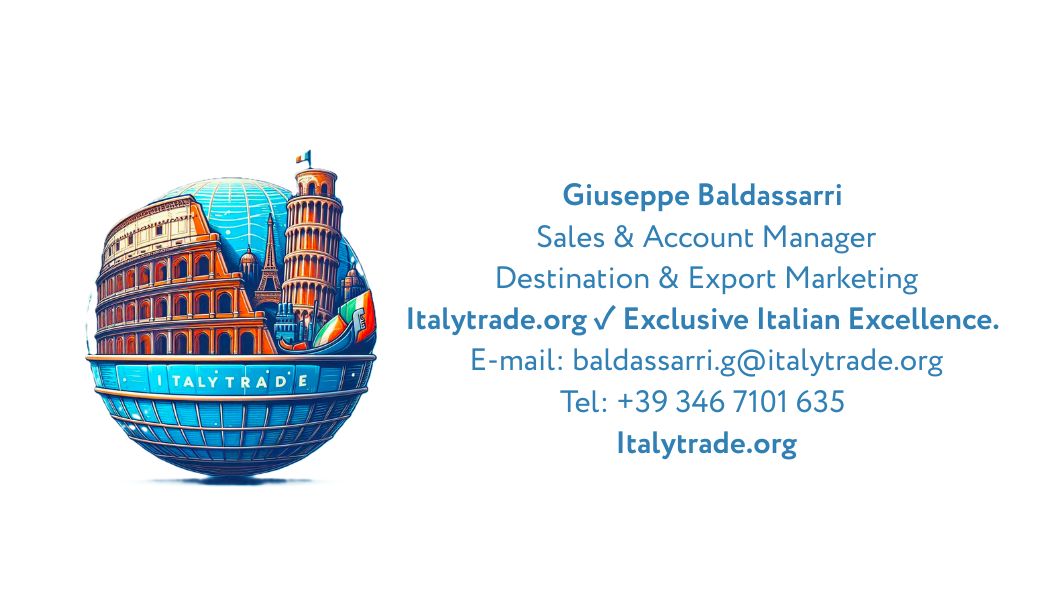
Customer Journey in Marketing: Optimizing the User Experience
A landscape that thrives with the seasons
In spring, the still snow-capped Sibillini Mountains provide the backdrop to a landscape of enchanting colors: farmhouses, blossoming orchards, vineyards, and cultivated fields create geometric patterns of beauty. Autumn dresses the valley in yellow, ochre, and brown, while winter gently whitens the hills and mountains.
This exceptional territory preserves the distinctive features of an agricultural landscape, a testament to the ancient wisdom that the Latin poet Virgil recognized in the "Novalia culta," expertly cultivated fields.
The Valdaso is not just a destination, but a rhythm of life to be discovered, step by step.
.Legal Information – Terms and Conditions
The websites baldassarrigiuseppe.it and italytrade.org are managed by:
Giuseppe Baldassarri ✓Sales & Account Manager – Destination & Export Marketing in Italy
Tax ID: BLDGPP63D15G920H
Address: Via Magellano n.28, 63824 Altidona (FM), Italy
The activity carried out falls under the occasional service provision regime pursuant to Article 2222 of the Italian Civil Code. For each service provided, a regular receipt for occasional services will be issued in compliance with current regulations.
Being an occasional activity:
- Services are not subject to VAT (art. 5, Presidential Decree 633/1972).
- If the client is subject to withholding tax obligations (e.g., company or professional with VAT number), a withholding tax of 20% will be applied to the gross amount of the service, as required by Italian tax legislation.
For any information, please contact Giuseppe Baldassarri at the email address: baldassarri.g@italytrade.org
